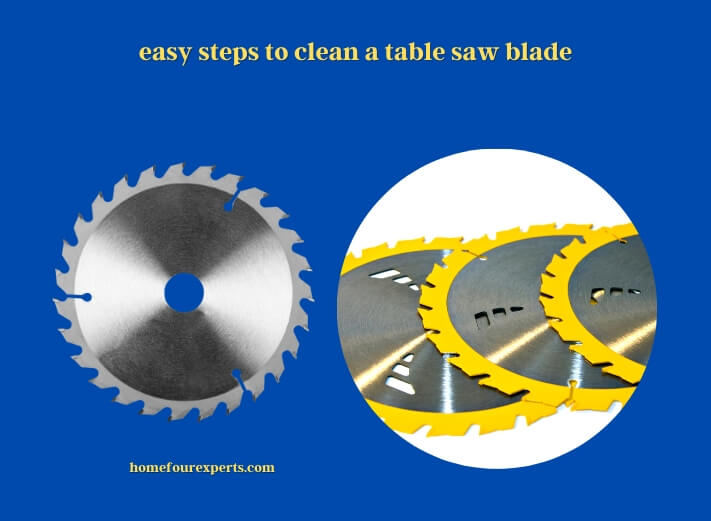Have you ever shaved your beard with a rusty razor? If the answer is yes then what was the experience afterward? You don’t need to answer that. The feeling is mutual when one cuts wood with a saw that has a dirty blade. One has to encounter frictional cuts resulting in potential loss of blood.
With such a glaring problem comes a solution, in this case, there are six of them. Cleaning a table saw is considered a novice task and with just a few methods it can act as a lifetime investment.
Before elaborating on six vital steps one must understand the fundamentality of having a clean blade for your saw. Over the course of time, your saw has elements that will wear down. The pitch of the saw creates edges for the blades. When that happens, the blade loses its sharpness as the resin covers the edges.
Also, during this period, the saw developed friction and heat, resulting in being virtually impossible to cut. So, when you cut the edges with a rusted knife the end product will receive minimal precision. Also, more than poor output dull blades are riskier to be around than clean ones. You need to be at your optimum physical force to cut with a dull blade, which will cause strain on the motor.

Step 1: Buy a Bucket of Lid
Having a bucket lid as a tray is a step that sounds very unconventional, but the nature of the blade makes it absolutely necessary to buy one. A five-gallon bucket lid is excellent for the purpose.
This is because it has a rim around the outside that will contain the liquid for cleaning the blade. The size of the lid is ideal for your saw blade and the specialty of the tray is the little dimple drawn on the center. It is positioned lower and that allows you to put your finger through the blade. You can use your finger to set the blade down and pick it up again from the center.
Why not use it in a regular tray? If you choose the conventional ones the biggest pitfall would have been that you have to grab the sharp teeth to pick up the blades. Not only it is inconvenient but also very unsafe. The best part about it is it is cheap.
Step 2: Choose the Right Cleaner
The second step involves finding the right cleaner for your saw blades. While there is an abundance of options, most of them are accused of being too aggressive. As someone who is an expert in this field, there is no point in using oven cleaner as it will only aggravate the quality of your blade.
Even something that requires using maximum protection of your hands to clean the blade is not someone most should not look forward to. When you have easier options why choose the risky ones? You need a cleaner that requires you to just drop your blades on the sink.
A small bottle-size tool cleaner is the only tool you need. While we are not offering personal recommendations of brands, choose those cleaners that are non-toxic. Buy the smaller options that are great value for money.
Step 3: Homemade Cleaning Options are Available too
If you feel that buying a cleaning solution is out of your reach financially, then there are homemade options that require minimal buying. You still have to buy it but most of the ingredients that are needed to make it are already possessed by you.
You can buy simple natural cleansers, liquid detergents, and others that are easily available in the local grocery store, and mix them with water. The only downside of this approach is that it will be much time consuming than the previous step. But who says time and money go hand in hand?
Step 4: Spray on Each Side of the Blade
Once you get your equipment ready, keep your blade on the tray and spray each tooth of the blade. Do it on the other side of it and let it soak. One must make sure not to let it sit enough to make the blades dry out. Rather, have adequate time so that you can manually loosen up the gunks that your blades are filled with.
Step 5: Use a Brush As an Additional Support
A brush is another tool that will act in handy while conducting a comprehensive cleaning of your table saw blades. Not any kind of brush will suffice, however, as a stiff bristle nylon brush is the only way to go. We do not recommend using any hard brushes or objects like stainless steel as it will hurt the teeth on the blade.
Simply use a nylon brush and scrub each tooth of the blade. Having a good scrubber saves you time and energy to scrub perfectly. After scrubbing you can notice whether it is still dark after wiping it off. If it is then the process needs to be repeated. Once it gets lighter the blade is ready to be used on the saw.
Step 6: Clean It Multiple Times otherwise Get It Sharpened
As the blade in the table saw is heavy, cleaning once may not be enough. Firstly examine the pressure it takes to move the blade If the pressure is high then multiple cleaning is required. Even after that, the blades don’t function smoothly look for a sharpener. When you get it sharpened, go for a local expert, otherwise mail it to the most trusted ones in your country.
FAQs
Should You Wax Your Table Saw?
You should wax your table because it will be easier to clean, reduce the chances of oxidation, and perhaps most importantly it reduces friction. Waxing your table saw is a feel-good thing. Just think about your home. A clean table saw just looks better and makes your workshop look neater.
How Often Should the Table Saw Blade Be Cleaned?
Table saw blades should be cleaned after each use. It is important to use a soft brush or cloth to remove any sawdust or debris that has accumulated on the blade. This will help to keep the blade sharp and prevent it from becoming damaged.
What Are the Most Effective Method to Keep a Table Saw?
- Clean all sawdust that has aggregated inside the saw bureau, change controls, pinion wheels, and engine.
- Grease up the cogwheels and rotate the focus with a drying shower ointment to keep the change systems working easily.
- Clean cutting sharp edges with pitch and gum remover.
What is the Best Way to Remove Dust and Debris From the Table Saw Blade?
The best way to remove dust and debris from a table saw blade is to use a soft brush or cloth and a vacuum cleaner. Start by brushing the blade to remove the dust and debris, and then use the vacuum cleaner to suck up the dirt. Be sure to wear safety goggles and gloves when handling the blade to avoid injury.
Conclusion
There you go with just six simple steps your old saw blade will offer virtually the same perfection as it once was when it is new. To hold your saw back from rusting over once more, try not to open it to dampness.
This is hard to do in the normal carport or workshop, yet you can find ways to diminish openness. Try not to set beverages and different devices on top of the table that may contain dampness. You should likewise occasionally reapply a layer of wax to ensure the surface.
Read more:
- 6 Reasons Why Your Table Saw Is Not Cutting Properly
- What Is the Purpose of a Table Saw Blade Guard
- 3 Easy Ways to Adjust Ryobi Table Saw Fence
About This Writer

Hello, I am David Rowan. I am a professional contractor with 10 years of experience in home building, different tools used, construction, home remodeling, and other home improvement work. I have already built many custom homes and continued to do several woodworking projects along with how to deal with all categories of tools.